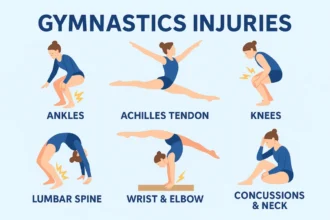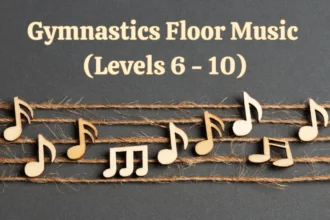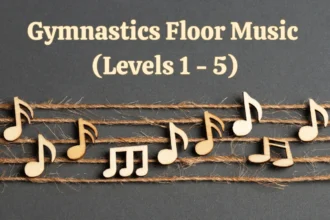In gymnastics, scores are influenced by both penalties and deductions, each affecting the final score in distinct ways. These scoring elements serve to maintain fair play, uphold technical standards, and ensure gymnasts adhere to competition rules.
While penalties and deductions both lower a gymnast’s score, they differ in terms of application, causes, and impact.
1. What is Deduction in Gymnastics?
A deduction is a reduction in the Execution Score (E-score) based on specific performance errors or flaws in technique, form, and artistry. Deductions reflect mistakes directly related to the gymnast’s skill execution and are assessed by judges who evaluate the quality of each element in a routine.
Types of Deductions
1. Execution Deductions
These focus on the technical aspects of a routine, such as body alignment, precision of movements, and overall form. Common execution errors include bent knees, flexed feet, and lack of jump amplitude.
Each error has a specific deduction value, typically ranging from 0.1 to 0.5 points, depending on its severity. For example:
- Bent Knees or Flexed Feet: Small form issues such as bent knees or unpointed toes are common deductions, often incurring a 0.1–0.3 reduction per occurrence.
- Wobbles on Balance Beam: A small wobble on beam can result in a 0.1 deduction, while a large balance check might lead to a 0.3 deduction.
- Landing Errors: Steps, hops, or stumbles on landings are deducted, with minor hops incurring 0.1 deductions and major stumbles up to 0.5 points.
- Falls: A fall on any apparatus, whether from losing balance or failing to complete an element, leads to a 1.0 deduction.
2. Artistry Deductions:
These pertain to the aesthetic and creative components of a performance. Factors like choreography, expression, and musicality are evaluated. For instance, a lack of expression or poor choreography can result in deductions of up to 0.3 points.
Application of Deductions
Judges assess routines starting from a base score (often 10.0) and subtract points for each detected error. The cumulative deductions determine the final execution score.
Example Routine with Execution Deductions:
- Bent knees on a jump: 0.1 deduction.
- Small hop on landing: 0.1 deduction.
- Minor wobble on beam: 0.1 deduction.
- Insufficient height on a tumbling pass: 0.3 deduction.
Total Execution Deductions = 0.1 + 0.1 + 0.1 + 0.3 = 0.6
If the gymnast started with a base execution score of 10.0, their final execution score would be: 10.0 – 0.6 = 9.4:
2. What is Penalty in Gymnastics?
Penalties, also known as neutral deductions, are point reductions applied for violations unrelated to the quality of the performance. These infractions involve breaches of competition rules or procedural errors.
What Do You Get a Penalty For?
Penalties are standardized and apply universally to all gymnasts. Unlike deductions for performance quality, penalties focus on rule adherence, highlighting the importance of discipline and precision.
Examples of Penalties:
- Time Limit Violations: Exceeding the time limit on floor exercise or beam results in a 0.1–0.3 penalty, applied directly to the final score.
- Out-of-Bounds: Stepping outside the designated boundaries on floor exercise incurs a 0.1–0.2 penalty per infraction.
- Attire Violations: Wearing unauthorized attire or jewelry, or failing to comply with uniform regulations, results in a 0.1–0.3 penalty.
- Failure to Salute Judges: Not saluting the judges before or after a routine may lead to a penalty, typically around 0.1–0.3 points.
- Unauthorized Coaching Assistance: Any assistance from a coach during a routine results in a penalty, often a 0.5 reduction or potentially more in severe cases.
How Penalties Are Applied to the Final Score
Penalties are subtracted from the combined total score after both the execution and difficulty scores are finalized:
Example Calculation:
- Execution Score: 8.8
- Difficulty Score: 6.2
- Total Before Penalties: 8.8 + 6.2 = 15.0
- Penalty: 0.3 (attire) + 0.1 (boundary) = 0.4
- Final Score: 15.0 – 0.4 = 14.6
5. Comparison of Deductions and Penalties
| Aspect | Deduction | Penalty |
|---|---|---|
| Purpose | Reflects execution errors and performance flaws | Enforces competition rules and guidelines |
| Impact on Score | Lowers the Execution Score (E-score) | Directly reduces the Total Score |
| Application | Based on technical performance across all apparatuses | Applied for rule violations and infractions |
| Examples | Bent knees, unpointed toes, landing steps | Out-of-bounds, attire infractions, time violations |
| Severity | Varies by error, up to 1.0 per mistake | Typically fixed, up to 0.5 or more |
| Frequency | Often applied multiple times per routine | Usually one-time, event-specific infractions |
6. Strategies for Minimizing Deductions and Penalties
To optimize their scores, gymnasts and coaches work on reducing both deductions and penalties, as each can impact competitive standings.
Minimizing Deductions:
- Refine Technique and Form: Consistent practice focusing on form helps minimize small deductions, such as bent knees or flexed feet.
- Improve Balance and Landing Skills: Working on stability can prevent wobbles and reduce landing deductions.
- Use Video Analysis: Reviewing routines on video helps gymnasts spot minor form errors and refine their skills.
Avoiding Penalties:
- Adhere to Time Limits: Practice routines with a timer to avoid exceeding time limits on floor and beam.
- Stay Within Boundaries: Train with boundary markers for spatial awareness, especially in floor exercise.
- Comply with Attire and Equipment Rules: Ensure that uniforms and equipment meet competition standards, and practice without jewelry or unauthorized accessories.
- Observe Competition Protocol: Always salute the judges and avoid delaying the start of routines after being signaled.
In summary, penalties and deductions both play a role in score reduction but serve different purposes. Deductions are applied for technical errors in execution, while penalties address rule violations and protocol infractions.
Together, penalties and deductions provide a balanced approach to scoring, rewarding athletes for their performance while ensuring that all competitors adhere to the same competition standards.





